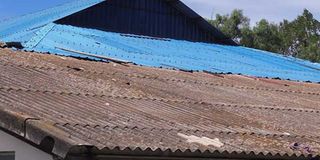Nema wants Nanyuki School’s asbestos roof replaced

A building at Nanyuki High School with asbestos roofing which Nema wants replaced with iron sheets saying it poses health risks to students and teachers. PHOTO | STEVE NJUGUNA | NATION MEDIA GROUP
What you need to know:
- Nema has advised the school to remove the asbestos roofing as it poses a health hazard.
- The management of Nanyuki High School has called on the government to help it remove the asbestos roofing.
- The principal said they are no longer harvesting rain water for fear of subjecting students to the dangerous metals.
As they study hard to pass their examinations, students of Nanyuki High School may at the same time be risking their health as they are learning under roofs made of asbestos.
But it is not only the learners who face this danger but also their teachers and other staff working in the school.
The National Environment Management Authority (Nema) in Laikipia County has advised the school to remove the asbestos roofing as it poses a health hazard.
According to Laikipia Nema Director Fanuel Mosago, the sheets wear off naturally and since they date back to the colonial period, they pose a health risk to the people.
CANCER RISK
Medical researchers say learning under old buildings with ageing and decomposing asbestos materials can increase the risk of getting lung cancer.
Mr Mosago warned that water collected from the roofs can cause cancer as elements accumulate in the body and that fibre emitted by the roofs can cause lung cancer if inhaled.
“We have advised anyone with asbestos roofing to remove it and seek guidance on how to dispose it,” he said.
The director said that they have issued regulations on how the asbestos are removed and safely buried in areas far from human settlements.
CALL FOR HELP
The management of Nanyuki High School has called on the government to help it remove the asbestos roofing following the warning by Nema.
The school’s principal Oliver Minishi confirmed that they intend to replace the asbestos roofing with iron sheets.
“Most of the school’s buildings have asbestos which has already started wearing off. We need help,” said Mr Minishi.
He said that the school is willing to remove the asbestos but it has no money, adding that the whole process of replacing and disposing the waste will cost Sh13.5 million.
The asbestos roofing is on some offices, classrooms, laboratories and teachers’ houses.
The principal said they are no longer harvesting rain water for fear of subjecting students to the dangerous metals.
But he said the school is also concerned about the runoff water that ends up in the school farm where they have planted vegetables.





